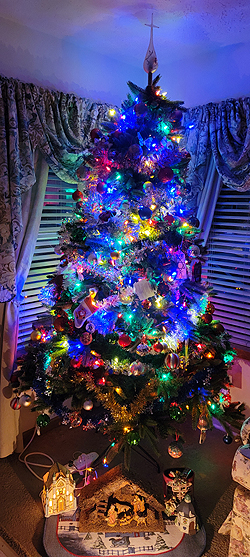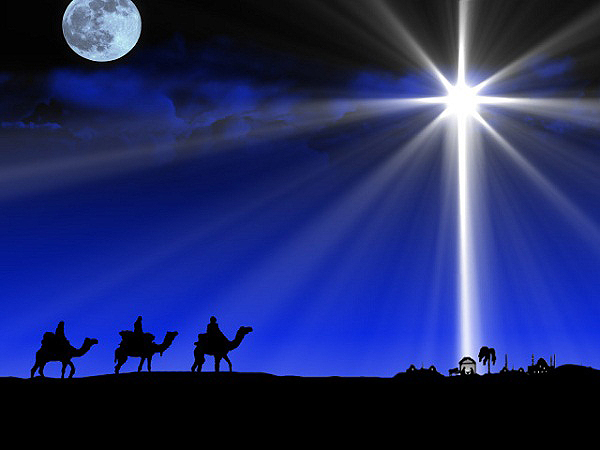|
The Light of Life Gives Hope in a Dark World |
||
|
The Christmas season is one of the most enjoyable times of the year. There is generally a lighter mood in the air, and people tend to be a little nicer and more charitable to each other. It is a time for family and friends to take time off from the routine hustle and bustle of life to come together in love, joy, fellowship, gift-giving, and great food. Most importantly, it is a season to remember the birth of Jesus, God's greatest gift to save fallen humanity and reconcile us to Himself.
One of my family's favorite traditions to kick off this season is setting up our Christmas tree in the great room, the most open and inviting space of the house. We enjoy listening to and sometimes singing Christmas carols and hymns as we decorate the tree with colorful ornaments, tinsel, and bright lights. At the base of the tree, we gently place an old wooden Nativity scene given to us as a gift from friends long ago, made by the Fontanini family of Bagni di Lucca, Italy. We have always appreciated its marvelously sculptured figurines of Mary, Joseph, and a few barn animals looking adoringly at the baby Jesus sleeping in a manger. The finale of this joyful joint effort is the placing of the star at the top of the tree, a bulb on which is an image of the baby Jesus resting on a cloud with emanating rays of light. The top of the bulb gets thinner, looking like a long teardrop, and stretches upward into a star, the beams of light forming a cross. On shorter winter days, it is quite dark outside and in the house when I get up in the morning. As sleep starts to leave my eyes, it warms my heart to see the Christmas tree lights spilling into the hallway, for it reminds me of Jesus Christ, the Light of the World, overcoming the darkness. This reminder engenders feelings of hope for whatever I may face in the day ahead. In the 2013 Canadian post-apocalyptic science fiction film The Colony, climate modification towers built to cool the climate by dimming the sun have malfunctioned, causing a deep freeze worldwide with perpetual cloud cover and snow blizzards. Survivors formed small colonies in underground bunkers to escape the extreme cold, with much of their time spent trying to produce enough food and control disease. Never seeing the sun caused a palpable dreariness in the hearts of colony residents, with a growing sense of futility and hopelessness. But one of these colonies received a message bouncing off a functioning satellite, where the leader of a distant colony showed a blue sky behind him with the sun shining. He said that at their location, the snow had thawed, and they were able to grow food outdoors. He offered refuge to anyone and asked them to bring seeds to plant. Once the location of this colony was determined, the residents, filled with hope of seeing the sun again, feeling its warmth, and living above ground with enough food, packed up what they could carry for the long, dangerous journey in the snow, the chief of which was a container of seeds.
The Magi were wise men, most likely from Persia, who were familiar with the writings of the prophet Daniel (chief of the court wise men of Persia about 500 years earlier) that included a timeline for the birth of the Messiah. They also may have known of the prophecy of Balaam of Pethor (a town on the Euphrates River near Persia), made nearly 900 years before Daniel, that said, "A star shall appear from Jacob; a scepter shall rise from Israel" (Numbers 24:17). Seeing the light of the star from Jacob, the Magi believed the word of God and recognized the fulfillment of this prophecy. They realized this newly born King from Israel was no ordinary king and perceived His divinity. With gladness and hope, the Magi embarked on the nearly thousand-mile journey, following "His star" to Bethlehem (Matthew 2:1-12), to the house where the Christ Child was with Joseph and Mary. When they found Jesus, they worshipped Him and gave the precious gifts of gold, frankincense, and myrrh. Even during what should be a festive season, depending on location and circumstances, the world can be a very dark place for many of us. Economic hardship, illness, the grief of missing loved ones who are estranged or have died, the tragic consequences of being in a war zone, political or religious persecution, and loneliness may feel like a continual cloud cover that brings dreariness, despair, and hopelessness. Henry Wadsworth Longfellow (1807-1882), on Christmas Day, 1863, wrote the poem I Heard the Bells on Christmas Day, which later became a well-known Christmas carol. The hatred, violence, and great suffering of the Civil War seemed to destroy the prospect of peace on earth and good will to men, but the sound of the church bells comforted him and reminded him that:
Seeing signs of light, even at a distance, gives hope that the darkness will give way and be overwhelmed by joy. This can cause people, like in The Colony, to take a long journey through harsh terrain and weather to fulfill the culmination of their hope of living in abundance under the sun. Or, like the Magi, travel from a faraway country to pay homage to the Word come in the flesh, the Savior of mankind (John 1:1-14). The darkness that inundates the world and causes all kinds of suffering comes from our own failures, mistakes, and sins against God, others, and ourselves. The world needs a Savior to rescue us from the darkness of our hearts and the eternal separation from God that it brings. Whenever I see the evergreen branches of our Christmas tree, I am reminded of the everlasting life with God that comes through the Savior, Jesus Christ. The ornaments of many varieties and colors represent all those of every tribe, tongue, and people who trust in Him and are united together, reflecting His unquenchable light and love, bringing to mind the words of Jesus:
Believe in the Lord Jesus. He is the Light of life that gives hope in the darkness, assuring its end and entrance into His eternal kingdom of light. |
||
| What Is the Gospel? | What Must I Do to Be Saved? | Home | Contact Us | Return | ||

